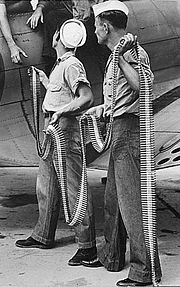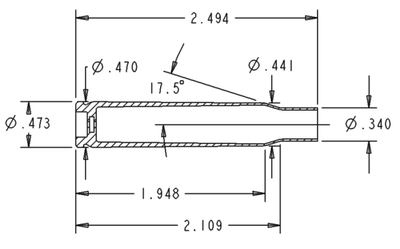.30-06 Springfield
| .30-06 Springfield | ||
|---|---|---|
From left to right 9.3x62mm, .30-06 Springfield, 8 x 57 IS, 6.5 x 55 and .308 Winchester cartridges. The 7.62x51mm NATO (not pictured) is similar in appearance to the .308 Winchester. |
||
| Type | Rifle | |
| Place of origin | ||
| Service history | ||
| In service | 1906 | |
| Used by | USA and others | |
| Wars | World War I, World War II, Korean War, Vietnam War | |
| Production history | ||
| Designer | United States Military | |
| Designed | 1906 | |
| Produced | 1906-present | |
| Specifications | ||
| Parent case | .30-03 | |
| Case type | Rimless, bottleneck | |
| Bullet diameter | 7.62 mm (0.300 in) | |
| Neck diameter | 8.63 mm (0.340 in) | |
| Shoulder diameter | 11.20 mm (0.441 in) | |
| Base diameter | 11.96 mm (0.471 in) | |
| Rim diameter | 12.01 mm (0.473 in) | |
| Rim thickness | 1.24 mm (0.049 in) | |
| Case length | 63.35 mm (2.494 in) | |
| Overall length | 84.84 mm (3.340 in) | |
| Case capacity | 4.43 cm³ (68 gr H2O) | |
| Rifling twist | 254 mm (1 in 10 in) | |
| Primer type | Large rifle | |
| Maximum pressure | 405 MPa (58,700 psi) | |
| Ballistic performance | ||
| Bullet weight/type | Velocity | Energy |
| 150 gr (9.7 g) Nosler Ballistic Tip | 2,910 ft/s (890 m/s) | 2,820 ft·lbf (3,820 J) |
| 165 gr (10.7 g) BTSP | 2,800 ft/s (850 m/s) | 2,872 ft·lbf (3,894 J) |
| 180 gr (12 g) Core-Lokt Soft Point | 2,700 ft/s (820 m/s) | 2,913 ft·lbf (3,949 J) |
| 200 gr (13 g) Partition | 2,569 ft/s (783 m/s) | 2,932 ft·lbf (3,975 J) |
| 220 gr (14 g) RN | 2,500 ft/s (760 m/s) | 2,981 ft·lbf (4,042 J) |
| Test barrel length: 24 inch Source: Federal Cartridge[1] / Accurate Powder[2] |
||


The .30-06 Springfield cartridge (pronounced “thirty-aught-six”, "thirty-oh-six") or 7.62 x 63 mm in metric notation, was introduced to the United States Army in 1906 (hence “06”) and standardized, used until the 1960s and early 1970s. It replaced the .30-03, 6 mm Lee Navy and .30 US Army (also called .30-40 Krag). The .30-06 remained the US Army's primary rifle cartridge for nearly 50 years before it was finally replaced by the 7.62 x 51 mm NATO (commercial .308 Winchester) and 5.56x45mm NATO (commercial .223 Remington), both of which remain in current U.S. and NATO service. It remains a very popular sporting round, with ammunition produced by all major manufacturers.
Contents |
History
Much of the rest of the world at the turn of the century was in the process of adopting the pointed spitzer bullet: France in 1898, Germany in 1905, Russia in 1908, Britain in 1910[3]. When it was introduced, the .30-03 was thus behind the times for this among other reasons. A new case was developed with a slightly shorter case neck to fire a higher velocity, 150-grain (9.7 g) spitzer bullet at 2,700 ft/s (820 m/s).
The M1903 Springfield rifle, introduced alongside the earlier cartridge, was quickly modified to accept the .30-06 cartridge, known as the M1906. Modifications to the rifle included shortening the barrel at its breech and recutting the chamber. This was so that the shorter ogive of the new bullet would not have to jump too far to reach the rifling. Other changes included elimination of the troublesome 'rod bayonet' of the earlier Springfield rifles.
Experience gained in World War I indicated that other nations' machine guns far outclassed American ones in maximum effective range. Additionally, before the widespread employment of light mortars and artillery, long-range machine gun 'barrage' or indirect fires were considered important in U.S. infantry tactics.[4] For these reasons, in 1926, the Ordnance Corps developed the .30 M1 Ball cartridge using a 174-grain (11.3 g) bullet with a 9 degree boat tail, traveling at a reduced muzzle velocity of 2,640 ft/s (800 m/s). This bullet offered significantly greater range from machine guns and rifles alike due to its increased ballistic coefficient. Additionally, a gilding metal jacket was developed that all but eliminated the metal fouling that plagued the earlier cartridge.
Wartime surplus totaled over 2 billion rounds of ammunition. Army regulations called for training use of the oldest ammunition first. As a result, the older .30-06 ammunition was expended for training; stocks of M1 ammunition were allowed to slowly grow until all of the older ammo had been fired. By 1936 it was discovered that the maximum range of the new M1 ammunition and its 174-grain (11.3 g), boat-tailed bullets was beyond the safety limitations of many ranges. An emergency order was made to manufacture quantities of ammunition that matched the ballistics of the older cartridge as soon as possible. A new cartridge was developed in 1938 that was essentially a duplicate of the old M1906 round, but with a gilding metal jacket and a different lead alloy, resulting in a bullet that weighed 152 grains (9.8 g) instead of 150. This cartridge, the Cartridge .30 M2 Ball, used a flat-based bullet fired at a higher muzzle velocity (2,805 ft/s) than either of its predecessors.
Firearms
It was used in the bolt-action M1903 Springfield rifle, the bolt-action M1917 Enfield rifle, the semi-automatic M1 Garand, the Famage Mauser, the Browning Automatic Rifle (BAR), and numerous machine guns, including the M1919 series. It served the United States in both World Wars and in the Korean War, its last major use being in Vietnam. Large volumes of surplus brass made it the basis for dozens of commercial and wildcat cartridges, as well as being extensively used for reloading. With "hot" hand-loads and a rifle capable of handling them, the .30-06 is capable of performance rivaling many "magnum" cartridges. The .30-06's power (combined with the availability of surplus firearms chambered for it and demand for commercial ammunition) has kept the round one of the most popular for hunting in North America. With appropriate loads it is suitable for large mammals such as deer, elk, and moose.
Performance
The .30-06 is a very powerful cartridge designed when 1,100 yd (1 km) shots were expected. In 1906, the original M1906 .30-06 cartridge consisted of a 9.7 grams (150 gr), flat-base cupronickel-jacketed-bullet. After WWI, the U.S. military needed better long-range performance machine guns. Based on weapons performance reports from Europe, a streamlined, 11.2 grams (173 gr) boattail, gilding-metal bullet was used. The .30-06 cartridge, with the 11.2-gram (173-grain) bullet was called Cartridge, .30, M1 Ball. The .30-06 cartridge was far more powerful than the smaller Japanese 6.5 x 50mm Arisaka cartridge and was still much more powerful than the Japanese 7.7 x 58 Arisaka as well. The new M1 ammunition proved to be significantly more accurate than the M1906 round.[5]
In 1938, the unstained, 9.8 grams (151 gr), flat-base bullet combined with the .30-06 case became the M2 ball cartridge. According to U.S. Army Technical Manual 43-0001-27, M2 Ball specifications required 835 metres per second (2,740 ft/s) velocity, measured 24 metres (79 ft) from the muzzle. M2 Ball was the standard-issue ammunition for military rifles and machine guns until it was replaced by the 7.62 x 51 mm NATO round for the M14 and M60. For rifle use, M2 Ball ammunition proved to be less accurate than the earlier M1 cartridge; even with match rifles, a target group of 5 inches (130 mm) diameter at 200 yards (180 m) using the 150-grain (9.7 g) M2 bullet was considered optimal, and many rifles performed less well.[5] The U.S. Marine Corps retained stocks of M1 ammunition for use by snipers and trained marksmen throughout the Solomon Islands campaign in the early years of the war.[6] In an effort to increase accuracy some snipers resorted to use of the heavier .30-06 M2 armor-piercing round, a practice that would re-emerge during the Korean War.[7] Others sought out lots of M2 ammunition produced by Denver Ordnance, which had proved to be more accurate than those produced by other wartime ammunition plants when used for sniping at long range.[8]
Commercially manufactured rifles chambered in .30-06 are popular for hunting. Current .30-06 factory ammunition varies in bullet weight from 7.1 g to 14.3 g (110 to 220 grains) in solid bullets, and as low as 3.6 g (55 grains) with the use of a sub-caliber bullet in a sabot. Loads are available with reduced velocity and pressure as well as increased velocity and pressure for stronger firearms. The .30-06 remains one of the most popular sporting cartridges in the world. Many hunting loads have over 2800 ft-lbs of energy at the muzzle and use expanding bullets that can deliver rapid energy transfer and hydrostatic shock to living targets.
| Bullet Weight (grains) | Commercial[9] | Hodgdon[10] | Speer[11] | Hornady[12] | Nosler[13] | Barnes[14] |
|---|---|---|---|---|---|---|
| 110 | N/A | 3505 | 3356 | 3500 | N/A | 3471 |
| 125/130 | 3140 | 3334 | 3129 | 3200 | 3258 | 3278 |
| 150 | 2900 | 3068 | 2847 | 3000 | 3000 | 3031 |
| 165 | 2800 | 2938 | 2803 | 2900 | 3002 | 2980 |
| 180 | 2700 | 2798 | 2756 | 2800 | 2782 | 2799 |
| 200 | N/A | 2579 | 2554 | N/A | 2688 | 2680 |
| 220 | 2400 | 2476 | N/A | 2500 | 2602 | 2415 |
The table above shows typical muzzle velocities (in ft/s) available in commercial 30-06 loads along with maximum 30-06 muzzle velocities reported by several reloading manuals for common bullet weights. Hodgdon, Nosler, and Barnes report velocities for 24" barrels. Hornady and Speer report velocities for 22" barrels. The data are all for barrels with a twist rate of 1 turn in 10” which is needed to stabilize the heaviest bullets. The higher muzzle velocities reported by Nosler for 165 grain and heavier bullets use loads employing a slow-burning, double-base powder (Alliant Reloder 22).
The newer 7.62x51mm NATO/.308 Winchester cartridge offers similar performance to standard military .30-06 loadings in a smaller cartridge. However, the greater cartridge capacity of the .30-06 allows much more powerful loadings if the shooter desires.
Cartridge dimensions
The .30-06 Springfield has a 68.2 grains (4.43 ml ) H2O cartridge case capacity. The exterior shape of the case was designed to promote reliable case feeding and extraction in bolt action rifles and machine guns alike, under extreme conditions.

.30-06 Springfield maximum C.I.P. cartridge dimensions. All sizes in millimeters (mm).
Americans defined the shoulder angle at alpha/2 = 17.5 degrees. The common rifling twist rate for this cartridge is 1 in 10 in., 4 grooves, Ø lands = .30 (7.62 mm), Ø grooves = .308 (7.82 mm), land width = .1768 (4.49 mm) and the primer type is large rifle.
According to the official C.I.P. (Commission Internationale Permanente pour l'Epreuve des Armes à Feu Portatives) guidelines, the .30-06 Springfield case can handle up to 58,740 psi (405 MPa) piezo pressure. In CIP-regulated countries, every rifle cartridge combination has to be proofed at 125% of this maximum C.I.P. pressure to certify for sale to consumers.
The 8x57mm JS is probably the closest European ballistic twin of the .30-06 Springfield.

.30-06 Springfield cartridge dimensions. All sizes in inches (in).
U.S. military cartridge types
NOTE: .30-06 cartridges are also produced commercially with many different bullets and to a number of different specifications.
- Armor Piercing, M2
- This cartridge is used against lightly armored vehicles, protective shelters, and personnel, and can be identified by its black bullet tip. Bullet is flat base, weight 163-168 grains.
- Armor Piercing Incendiary, T15/M14 and M14A1
- This cartridge may be substituted for the M2 armor piercing round and is normally employed against flammable targets. The tip of the bullet is colored with aluminum paint. The M14A1 featured an improved core design and incendiary charge.
- Ball, M1906
- This cartridge is used against personnel and unarmored targets, and can be identified by its silver-colored bullet. The M1906 has a 9.7 g (150 grain) projectile and flat base. Its jacket is a cupro-nickel alloy which was found to quickly foul the bore.
- Ball, M1
- The M1 has a 11.2 g (173 grain), nine-degree boat-tailed projectile designed for aerodynamic efficiency. Though it had a lower initial velocity, velocity and energy were greater at longer ranges due to its efficient shape. The jacket material was also changed to gilding metal to reduce fouling.
- Ball, M2
- With a 9.8 g (152 grain) bullet based on the profile of the M1906, this cartridge incorporated the gilding-metal jacket of the M1 projectile combined with a slightly heavier, pure-lead core. It had a higher muzzle velocity than either of the earlier cartridges.
- Blank, M1909
- This cartridge is used to simulate rifle fire. The cartridge is identified by having no bullet, and by a cannelure in the neck of the case which is sealed by red lacquer.
- Dummy, M40
- This cartridge is used for training. The cartridge has six longitudinal corrugations and there is no primer.
- Explosive, T99
- Development of a cartridge that contained a small explosive charge which more effectively marked its impact. Often referred to as an "observation explosive" cartridge, the T99 was never adopted.
- Incendiary, M1917
- Early incendiary cartridge, bullet had a large cavity in the nose to allow the material to more easily shoot forward on impact. As a result the M1917 had a tendency to expand on impact. The M1917 had a blackened tip.
- Incendiary, M1918
- Variant of the M1917 with a normal bullet profile to comply with international laws regarding open-tipped expanding bullets.
- Incendiary, M1
- This cartridge is used against unarmored, flammable targets. The tip of the bullet is painted blue.
- Match, M72
- This cartridge is used in marksmanship competition firing, and can be identified by the word "MATCH" on the head stamp.
- Tracer, M1
- Tracer for observing fire, signaling, target designation, and incendiary purposes. The M1 has a red tip.
- Tracer, M2
- Tracer for observing fire, signaling, target designation, and incendiary purposes. Has a short burn time. The M2 originally had a white tip, but then switched to a red tip like the M1.
- Tracer, T10/M25
- Improved tracer over M1/M2. Designed to be less intense in terms of brightness than either the M1 or M2 tracers. The M25 had an orange tip.
- Rifle Grenade Cartridges, M1, M2, and M3/E1
- These cartridge are used in conjunction with the M1 (for the M1903 rifle), M2 (for the M1917 rifle), and the M7 series (for the M1 rifle) grenade launchers to propel rifle grenades. The cartridge has no bullet and the mouth is crimped. The differences between the three cartridges have to do with the powder charge and the subsequent range of the launched grenade. The M3E1 also featured an extended case neck.[15][16]
United States Military firearms using the .30-06 cartridge

- M1903/M1903A3 bolt-action rifle using Mauser-licensed stripper clips.
- M1917 Enfield rifle, loading from stripper clips.
- Gatling gun: Some U.S. Gatling guns were re-chambered for .30-06.
- Model 1909 Machine Rifle: The Benet-Mercie light machine gun was chambered for .30-06.
- M1917 Chauchat: The US used a mix of Chauchats in .30-06 and 8 mm Lebel.
- Lewis gun The US used a limited amount of Lewis guns chambered in .30-06 in both WWI and WWII.
- M1917 Machine Gun water-cooled and M1919 Machine Gun air-cooled machine guns, feeding from belts
- M1918 Browning Automatic Rifle, loading from detachable magazines.
- Marlin machine gun: Similar to the Colt-Browning machine gun ('Potato Digger'), but without 'digger' piston, and used mainly on aircraft.
- M1 Garand rifle, loading in an en bloc clip.
- M1941 Johnson Rifle, feeding from an internal rotary magazine.
- M1941 Johnson LMG, feeding from magazine.
See also
- Hydrostatic shock
- Caliber conversion sleeve
- List of rifle cartridges
- Table of pistol and rifle cartridges
- 7 mm caliber
- .303 British
- Delta L problem
- sectional density
- Descendant Wildcat Cartridges
References
- ↑ "Federal Cartridge Co. ballistics page". http://www.federalcartridge.com/ballistics/. Retrieved 2007-09-21.
- ↑ "Accurate Powder reload data table" (PDF). http://www.accuratepowder.com/data/AccurateGuideV3-2.pdf. Retrieved 2009-02-09.
- ↑ http://www.303british.com/id19.html
- ↑ George, John (Lt. Col.), Shots Fired In Anger, NRA Press (1981), pp. 402-403
- ↑ 5.0 5.1 Dunlap, Roy, Ordnance Went Up Front, Samworth Press (1948), p. 303
- ↑ George, John (Lt. Col.), Shots Fired In Anger, NRA Press (1981), p. 409
- ↑ Rocketto, Hap, Biography: William S. Brophy, Civilian Marksmanship Program http://clubs.odcmp.com/cgi-bin/distinguishedStory.cgi?distID=6674
- ↑ George, John (Lt. Col.), Shots Fired In Anger, NRA Press (1981), pp. 81, 428, 434-435
- ↑ http://www.federalpremium.com/products/rifle.aspx accessed 15 May 2010
- ↑ Hodgdon Powder Company, Cartridge Load Recipe Report, 3/27/2010, data.hodgdon.com
- ↑ Speer Reloading Manual Number 12, 1994, Blount, Inc., Lewiston, ID. pp. 286-294.
- ↑ Hornady Handbook of Cartridge Reloading, Fourth Edition, 1991, Hornady Manufacturing Company, Grand Island, NE. pp. 343-350.
- ↑ Nosler Reloading Guide Number Four, 1996, Nosler, Inc., Bend OR. pp. 322-329.
- ↑ Barnes Reloading Manual Number 2-Rifle Data, 1997, Barnes Bullets, Inc., American Fork, UT. pp. 381-386.
- ↑ "Gary's U.S. Infantry Weapons Reference Guide - .30 Caliber (.30-06 Springfield) Ammunition". http://www.inetres.com/gp/military/infantry/rifle/30_ammo.html. Retrieved 2007-09-21.
- ↑ "An Introduction to Collecting .30-06". http://cartridgecollectors.org/30-06intro/. Retrieved 2007-09-21.
- C.I.P. CD-ROM edition 2003
- C.I.P. decisions, texts and tables (free current C.I.P. CD-ROM version download) (ZIP and RAR format)
|
|||||||||||||||||||||||
|
|||||||||||||||||||||||